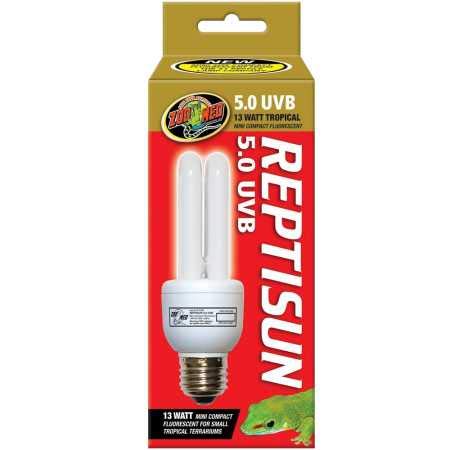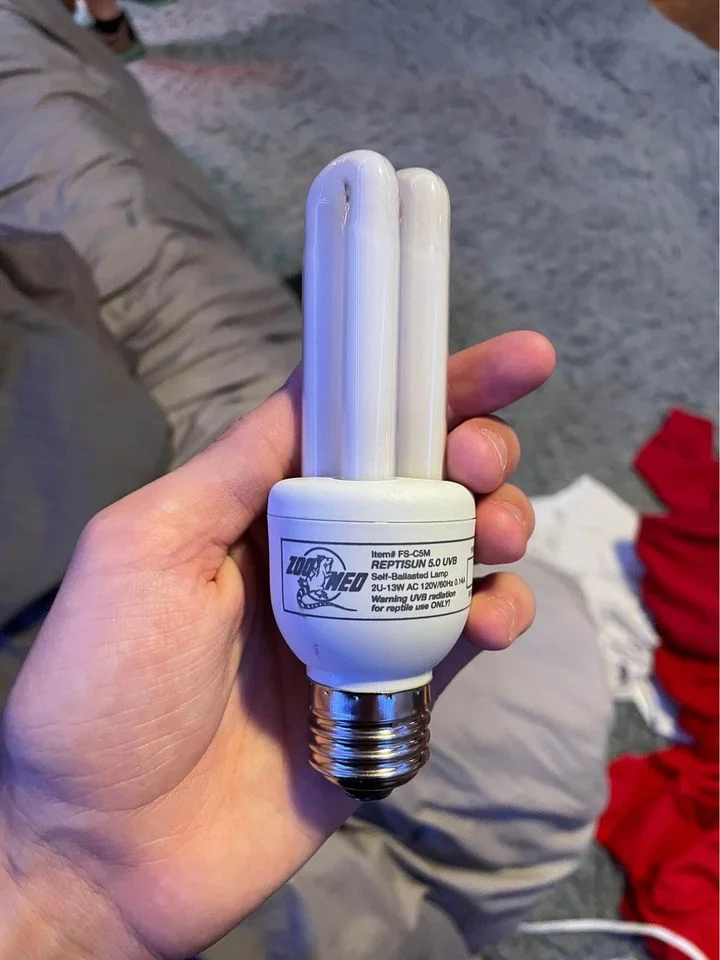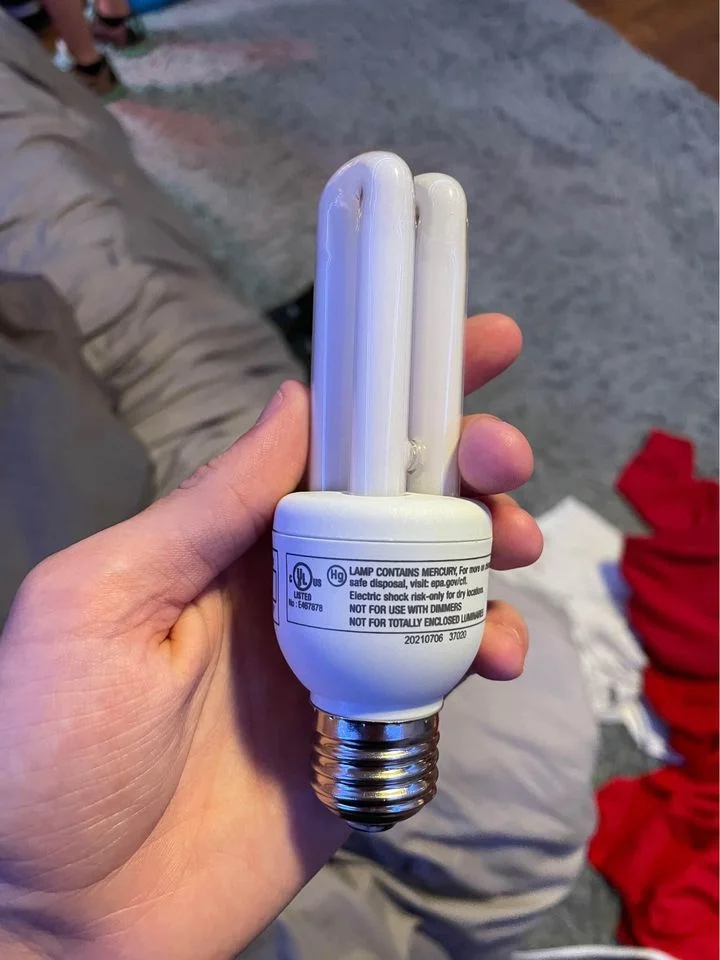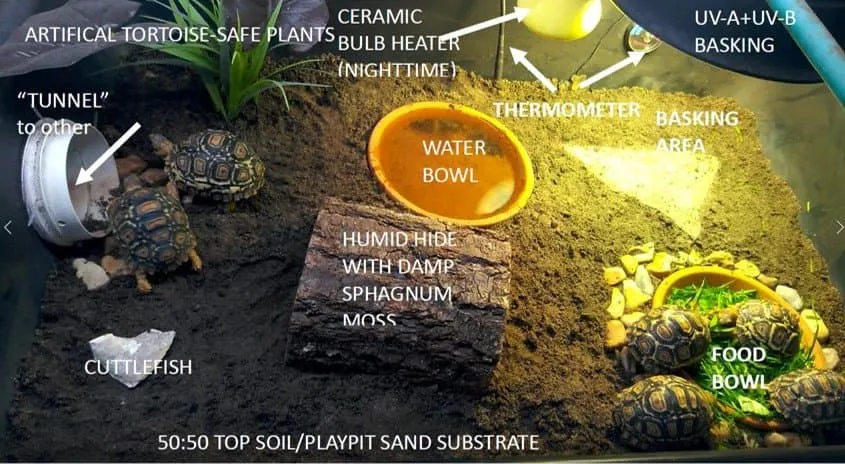This post contains affiliate links and I will be compensated if you make a purchase after clicking on my links.
Tortoises are generally low-maintenance pets, at least when compared to dogs or cats.
You can literally leave them outside to feed on weeds and they would still live their astoundingly long lives, provided that the climate allows it, of course.
That said, tortoises do have needs that are specific to them, and in order to make the most out of their inherent hardiness, you will have to meet those needs.
One such need is UV light, which can be provided by sunlight, or if that’s not possible, UVB lighting.
You would want a bulb that produces the same amount of UVB as natural sunlight or enough of what tortoises are used to in the wild. There are a lot of UVB bulbs on the market, but not all of them are a great match for your tortoise.
Any less would lead to them developing a calcium deficiency. There are also UVB bulbs out there that also produce heat, which your tortoise will also need to live a comfortable and healthy life.
The Best UVB Light Bulbs For Tortoise changes depending on your tortoise and your preferences, but let’s try to break UVB lighting down and find out which one suits you best.
Here Are the Best UVB Light Bulbs For Tortoise
| Image | Product | Features | Price |
|---|---|---|---|
Best Overall  | Zilla 18 inch Fluorescent Bulb
| 9.7 | Click For PriceBuy On Chewy |
Runner-Up  | Zoo Med ReptiSun Mini Compact Fluorescent Bulb
| 9.5 | Click For PriceBuy On Chewy |
 | Exo Terra Repti-Glo Terrarium Lamp
| 9.1 | Click For Price |
 | Fluker’s Sun Spot Mercury Vapor Lamp
| 8.8 | Click For PriceBuy On Chewy |
 | Zoo Med Reptisun 22 Inch Fluorescent Bulb
| 8.6 | Click For PriceBuy On Chewy |
Best UVB Light Bulbs For Tortoises: Reviews
- It can last for up to 12 months of continuous use
- Great for enhancing colors
- It’s only at 15 watts, making it safe even for long periods of time.
Zilla’s 18-inch fluorescent bulb is a tube-type UVB bulb, which will allow you to mount it along the length of your enclosure, providing complete UVB coverage.
This bulb comes in a 50 T8 model specifically for desert species, and a 25 T8 model perfect for forest tortoises.
Both of these models run at 15 watts and will need a specialized fixture to use. Some shops sell the fixture and the bulb separately, but there are ones that sell them together at a discount.
This bulb also produces full spectrum lighting, which can help enhance the natural colors of your enclosure, as well as encourage the natural behavior of your tortoise.
- Well-designed compact build
- Reliable and durable
- Great UVB output
Zoo Med’s Compact UVB bulb is a good choice if you want something that doesn’t take up much space and doesn’t have a high power requirement.
This UVB bulb has a 10.0 variant meant for desert species, and a 5.0 variant, which is perfect for tropical or forest species.


Because of how small they are, these bulbs do need a reflective dome to be effective. They also have a limited range compared to larger UVB bulbs.
Still, they can produce as much UVB as other bulbs at the fraction of the price.
- 100 watts
- Can be combined with Daytime Heat Lamp
- Can be used in a variety of enclosures
Another compact UVB bulb is Exo Terra’s Repti-Glo Terrarium Lamp. Much like Zoo Med’s Reptisun bulb, these bulbs produce ample amounts of UVB.
They also come in a desert variant and a tropical variant. Unlike Zoo Med’s version, however, Exo Terra’s compact bulbs are coiled, as opposed to straight.
There isn’t much difference between straight or coiled bulbs, and whichever is best ultimately depends on your own preference.
- Has a long-lasting lifespan of 5,000 hours
- Comes equipped with hard glass that successfully transmits UV
- Can be used in many different types of tanks and enclosures
If you want a multipurpose lamp that produces both UVB and heat, then Fluker’s mercury vapor lamp should do the trick.
It produces enough heat and UVB for a single basking spot and comes in a 100-watt version and a 160-watt version.
This bulb can heat up rather quickly, so be sure to use it on larger enclosures only.
These lamps do have a safety mechanism that turns the bulb off when it overheats and wouldn’t allow you to turn it on for 15 minutes after triggering this mechanism.
- Ideal for large Enclosures
- Can be used above screens
- Designed to help prevent or reverse metabolic bone disease
Another tube-type fluorescent UVB bulb is Zoo Med’s Reptisun T5-Ho model. Much like Zilla’s version, this allows coverage for the entire enclosure.
It also produces little to no heat. This model is 22 inches long and does require a specific fixture in order to be used.
Aside from UVB, this lamp also produces full-spectrum lighting that encourages your tortoise’s natural behavior.
The Thing About Ultraviolet Light
If you’ve lived long enough, then UV light might have a negative connotation for you.
There have been a lot of misconceptions regarding ultraviolet light, especially ones connected to skin cancer.
Despite this, however, UV light plays an important role in certain bodily functions, and cutting it off entirely leads to a very unhealthy life.
In fact, a complete lack of UV light might prove fatal in the long run. This is true for many animals, and that includes tortoises.
UVB bulbs are an important part of your tortoise’s habitat, especially if you are keeping them indoors, where sunlight is unavailable.
They allow your tortoise to develop healthier bones and prevent a whole host of bone diseases, including the infamous metabolic bone disease.
UV light itself is essential for producing vitamin D. Vitamin D helps the body metabolize calcium and store it in the bones.
Without it, tortoises will develop brittle bones and a rubbery shell, which is supposed to be rigid.
Even if you feed your tortoise calcium-rich food or enhance their diet with calcium supplements, without vitamin D, the calcium will simply pass through its digestive tract without being utilized by the body.
Of course, as we’ve mentioned before, too much of a good thing can do harm to your tortoise. Having an overpowered UVB lamp can cause burns on your tortoise.
One of the biggest problems that are associated with UVB bulbs is that some of them can burn your tortoise’s cornea, effectively blinding them.
This is a problem with older UVB bulbs, so newer models shouldn’t have this problem. Still, it’s best to be aware of this possibility.
You should also keep in mind how much exposure to UVB your tortoise will need.
Desert or grassland tortoises tend to bask under the sun, so they are more tolerant of higher concentrations of UV.

On the other hand, tortoises that live in the forests rarely have access to direct sunlight, given that they live under a thick canopy.
Placing a UVB bulb that is meant for desert species on tortoises that are not used to direct sunlight can be disastrous.
Types of UVB Bulbs
As we’ve mentioned before, there are many types of UVB bulbs out there, each with its own specific features.
Which type of bulb works best for you and your pet ultimately depends on how you’ve set up your tortoise enclosure.
Before you purchase a new bulb, make sure that it matches the wattage of your fixture to avoid accidental fires or blowing out your bulb, which can be harmful to your tortoise.
Of course, unlike heat lamps, UVB bulbs tend to be lower in wattage, since they don’t have to produce a lot of heat. Still, it’s best to be 100% sure.
Here are some of the most common UVB bulbs you can find in the market.
Regardless of the type of UVB bulb you purchase, you will need to replace them every 10 to 12 months.
UVB bulbs lose their ability to produce UV light over time, so it’s best to replace them regularly, even if they are still producing visible light.
Compact Fluorescent Bulb
As their name would suggest, compact UVB bulbs tend to be smaller and lower in wattage than regular UVB bulbs.
Of course, that doesn’t mean they can’t produce UVB like their larger counterparts. They can be straight in shape or spiral, otherwise referred to as coiled bulbs.
Both work the same way, but for tortoises, many breeders prefer to use straight bulbs over coiled ones. These bulbs tend to have lower running costs than their larger counterparts.
One downside to compact bulbs is that they are reliant on deep reflectors in order to be effective. Their overall range also leaves much to be desired.
You will need to move them closer to the base of your enclosure to be effective. This can increase the chance of causing eye injury to your tortoise since the light source will also be closed.
Tube-type Bulb
Most screw-on bulbs available tend to have a limited range. They won’t be enough to cover the entire enclosure, usually only an area a few inches in diameter.
They work well enough if your tortoise tends to bask, as you have a general idea of where they hang out.
But tortoises that don’t bask, might not get the right amount of UVB, since they might not spend a lot of time under the bulb itself.
Tube-type fluorescent bulbs can help cover your entire enclosure in UVB light, allowing your tortoise to receive their needed UVB even if they don’t bask.
They’re an excellent choice for larger enclosures, as the entire length of the bulb can produce UVB.
One downside is that you will need specialized fixtures for these bulbs since you can’t screw them onto just any fixture like traditional bulbs.
Mercury Vapor Bulbs
Most UVB bulbs available on the market are fluorescent. They don’t produce a lot of heat, so if you don’t have a heat source in your enclosure, you might need to get a separate bulb that does.
This means getting two fixtures just to provide the proper light and heating. Or you might need to get a heat mat on top of getting a UVB bulb.
Mercury vapor bulbs are unique in that they also produce a lot of heat on top of producing UVB. Enough heat, in fact, to keep your tortoise comfortably toasty.
A downside to mercury vapor bulbs or halogen bulbs is that sometimes, they are too good at producing heat. This makes them a poor choice for smaller enclosures.
If you have a larger habitat, however, mercury vapor bulbs are an efficient way to provide proper lighting and temperature for your tortoise.
